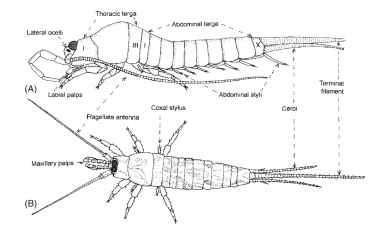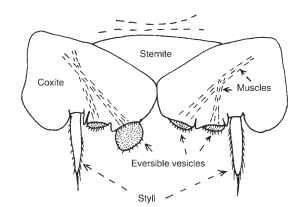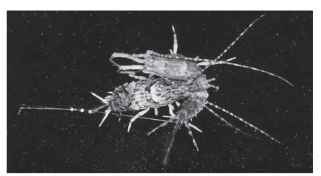Archaeognatha
(Bristletails)
The Archaeognatha (Microcoryphia; part of the subdivided order Thysanura) are apterygote insects with a body size between 6 and 25 mm and a cylindrical shape ( Fig. 1 ). The eyes are large and contiguous, and there are two lateral and one median ocelli (small single eyes with a single beadlike lens). The flagellate (whiplike) antennae extend one-half to three times the length of the body. The mouthparts are ectognathous (freely visible) and the mandibles are linked with the head by a monocondylic joint (i.e., one point of attachment). Some authors believe that this feature distinguishes the Archaeognatha from all other ectognathous Insecta. The seven-segmented maxillary palps are longer than the legs. The thoracic tergites II + III are in lateral view strongly arched, and the two or three tarsal segments of the legs are rigidly united (Fig. 2). Some taxa have additional scopulae (dense brushes of specialized hairs) on the distal end of the third tarsal segment. There are mostly pairs or double pairs of eversible vesicles on the coxites of the abdomen (Fig. 3). On each of the abdominal coxites II to IX, styli (pointed, nonarticulated processes) are present (Fig. 3).

FIGURE 1 A male archaeognathan (Machilis germanica), body length ca. 12 mm, lateral view; for details see Fig. 2.

FIGURE 2 General structure of Archaeognatha, semidiagram-matic. (A) Lateral view. (B) Dorsal view, color pattern of dorsal scales intimated.

FIGURE 3 Abdominal coxites III of M. germanica, ventral view. The eversible vesicles can be exserted by increasing the inner pressure and retracted by muscles.
Females have two long gonapophyses on each of the abdominal segments VIII + IX, forming the ovipositor. The penis of the males on abdominal segment IX varies in length, and in Machilidae it is fitted with paired parameres on abdominal segments IX or VIII + IX. The three filiform and scaled caudal appendages (one long filum terminale and two laterally inserted cerci) are directed backward. Tergites, cerci, and coxites are always scaled. The molts continue in adult stages. Many species are petrophilous (living on and under stones). The order comprises about 500 species in two families (Machilidae and Meinertellidae).
FOSSIL RECORD, SYSTEMATICS, AND BIOGEOGRAPHY
The fossil record of Paleozoic and Mesozoic apterygotes is poor, and many of the fossils of ectognathous representatives cannot be clearly assigned to extant orders. From the Mesozoic, the only archaeog-nathan fossil is Cretaceomachilis libanensis from the lower Cretaceous of Lebanon. For the Cenozoic period, there are many fossils of Archaeognatha, most being amber inclusions. For example, from Baltic amber (ca. 35mya), seven species of Machilidae are known. All extant forms and the fossils from the Cretaceous and the Tertiary can be included in the superfamily Machiloidea. This group includes two families, the more primitive Machilidae (46 genera and some 325 species), with three subfamilies (Machilinae, Petrobiinae, Petrobiellinae), and the more derived Meinertellidae (19 genera and some 170 species).
The Machiloidea are distributed worldwide. Only the Meinertellidae occur in South America, the Caribbean, South Africa, Australia, and Melanesia. Both Machilidae and Meinertellidae occur in the United States.
BEHAVIOR AND ECOLOGY
The mating behavior of archaeognathans is unique. There are three different modes of sperm transfer. In the most widespread and unique mating behavior, a carrier thread is used. In Machilis germanica, for example, the male approaches the female and drums on her with his long maxillary palps. The female shows “willingness” to mate by moving toward the male and bending up the tip of her abdomen. The male then attaches a secreted thread to the ground with his parameres. While the thread is being drawn out, the male secretes three to five sperm droplets onto the thread (Fig. 4 ). The male curves simultaneously around the female, preventing her from moving forward. Finally, the male places the sperm droplets onto the

FIGURE 4 Mating position of M. germanica, dorsal view. The male has drawn out a secreted thread, deposited three sperm droplets on the thread, and taken up a U form. The ovipositor of the female is touching one of the sperm droplets.
ovipositor of the female. The indirect transmission of sperm droplets, which are deposited on a thread stretched between parameres and the ground, is unique within the animal kingdom. At least two other possibilities of indirect sperm transfer are known. In Petrobius (Machilidae), the sperm are moved directly from the penis onto the ovipositor of the female and in all Meinertellidae, sperm are transferred by stalked spermatophores deposited on the ground.
Archaeognatha are found in habitats with very different climates. Representatives of the genus Allopsontus (Machilidae) are found up to 5000 m in the Himalayan region. In contrast, two meinertellid species live in the Amazonian forest. Some genera (e.g., Petrobius) are found near the seacoast. In tropical forests, meinertellid genera are found on the leaves of bushes and trees. Most Archaeognatha feed on green algae, lichens, and dead leaves. Several species of spiders probably are their principal predators.
Their protection against enemies is probably provided by three main factors: (1) the presence of long appendages with sensilla (filum terminale, cerci, antennae); (2) a dense scale cover on the relatively thin and flexible tergites and coxites; and (3) their ability to jump, which is fully developed in all free-living stages and in all recent representatives, and probably is their most effective defense.
PHYSIOLOGY
The cuticle of the Archaeognatha is generally thin and flexible and bears a multitude of sensory setae and other sensory organs. The hypopharynx (a mouthpart between maxillae and labium) is well developed. The coxal vesicles absorb fluids; their number varies from none to two within a coxite. In all machilid males, coxite IX bears the penis (length from 3/4 of the coxite to 1% in Machilidae, in Meinertellidae ca. % of the coxite length). In females, the paired gonapophyses on coxites VIII and IX form the ovipositor. It is of different length and has generally a specific chaetotaxy in each species.
DEVELOPMENT
The eggs (diameter 0.7 – 1.3 mm) are deposited into crevices of rocks or bark, and this stage lasts 60-380 days. Developmental stage I (first free-living larva) has a distinct prognathy, a strong forward projection of parts of the maxillae (laciniae), which aids in emergence from the egg, and rodlike setae on the head and the terga. These features disappear after the first molt. From developmental stage III onward, a scale cover is present in all terga and on abdominal coxites and caudal appendages. The molts continue during adult life.
